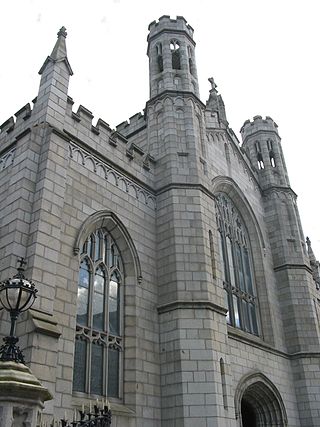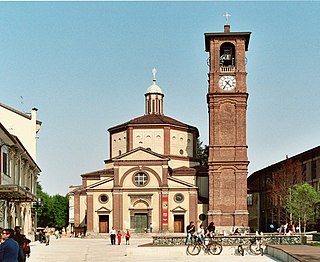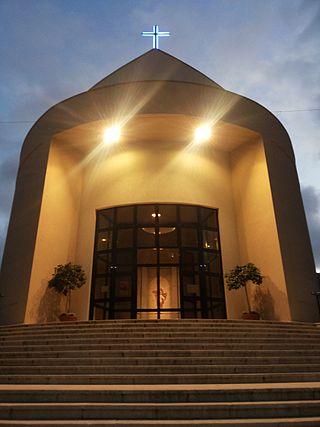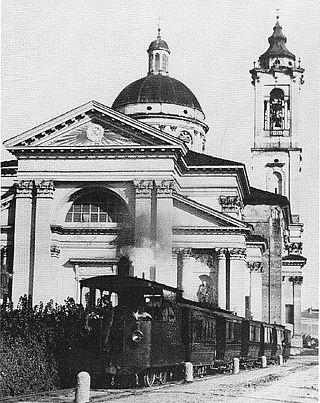
The Papal Basilica of Saint Peter in the Vatican, or simply Saint Peter's Basilica, is a church of the Italian High Renaissance located in Vatican City, an independent microstate enclaved within the city of Rome, Italy. It was initially planned in the 15th century by Pope Nicholas V and then Pope Julius II to replace the ageing Old St. Peter's Basilica, which was built in the fourth century by Roman emperor Constantine the Great. Construction of the present basilica began on 18 April 1506 and was completed on 18 November 1626.

Legnano is a town and comune (municipality) in the province of Milan, about 20 kilometres (12 mi) from central Milan. With 60,259, it is the thirteenth-most populous township in Lombardy. Legnano is located in the Alto Milanese and is crossed by the Olona River.

Alberto da Giussano is a legendary character of the 12th century who would have participated, as a protagonist, in the battle of Legnano on 29 May 1176. In reality, according to historians, the actual military leader of the Lombard League in the famous military battle with Frederick Barbarossa was Guido da Landriano. Historical analyses made over time have indeed shown that the figure of Alberto da Giussano never existed.

Fontaneto d'Agogna is a comune (municipality) in the Province of Novara in the Italian region Piedmont, located about 90 kilometres (56 mi) northeast of Turin and about 25 kilometres (16 mi) northwest of Novara. It takes its name from the Agogna stream.
San Giorgio su Legnano is a comune (municipality) in the Metropolitan City of Milan in the Italian region Lombardy, located about 20 kilometres (12 mi) northwest of Milan.

The Tempio della Beata Vergine della Ghiara, also known as Basilica della Madonna della Ghiara, is a church in Reggio Emilia, northern Italy. The building is the property of the comune (municipality) of the city.

Bernardo Antonio Vittone was an Italian architect and writer. He was one of the three most important Baroque architects active in the Piedmont region of Northern Italy; the other two were Filippo Juvarra and Guarino Guarini. The youngest of the three, Vittone was the only one who was born in Piedmont. He achieved a synthesis of the spatial inventiveness of Juvarra and the engineering ingenuity of Guarini, particularly in the design of his churches, the buildings for which he is best known.

The Basilica of San Lorenzo Maggiore is a Roman Catholic church in Milan, Northern Italy. Located within the city's ring of navigli, it is one of the oldest churches in the city, originally built in Roman times, but subsequently rebuilt several times over the centuries. It is close to the medieval Porta Ticinese and near the Basilicas Park, which includes both the Basilica of San Lorenzo and the Basilica of Sant'Eustorgio, as well as the Roman Colonne di San Lorenzo.

The Basilica of Saint Nicholas of Tolentino is a Roman Catholic church and minor basilica that is part of the Augustinian monastery in the hill-town of Tolentino, province of Macerata, Marche, central Italy. The church is a former cathedral of the Roman Catholic Diocese of Tolentino, suppressed in 1586.

Padua Cathedral, or Basilica Cathedral of Saint Mary of the Assumption, is a Catholic church and minor basilica located on the east end of Piazza Duomo, adjacent to the bishop's palace in Padua, Veneto, Italy.

The Cathedral of Saint Patrick and Saint Colman or Newry Cathedral is a Roman Catholic cathedral located in Newry, Northern Ireland. It acts as the seat of the Bishop of Dromore, and the Mother church of the Roman Catholic Diocese of Dromore. Prior to the COVID-19 pandemic, over 200,000 people visited the cathedral each year. The cathedral sits on Newry's Main Street and is a Grade A listed building.

The Company of Death is the name used in the historical literature of English language for two related chosen tactical corps, two selected bands of warriors, entrusted to guarantee the cohesiveness and efficiency in battle of both the Milanese and Lombard League's militias through their bond by oath to the defence of the Milanese Carroccio, the wagon on which the standard of the Lombard allies stood.

The church of Santa Maria Assunta, known as I Gesuiti, is a religious building in Venice, Italy. It is located in the sestiere of Cannaregio, in Campo dei Gesuiti, not far from the Fondamenta Nuove.

The Basilica of Saint Magnus is the principal church of the Italian town of Legnano, in the province of Milan. It is dedicated to the Saint Magnus, who was Archbishop of Milan from 518 to 530. The church was built from 1504 to 1513 in the Renaissance-style designed by Donato Bramante. The bell tower was added between the years 1752 and 1791. On 18 March 1950, Pope Pius XII named the Basilica of San Magno a minor basilica.

Sacro Cuore is a Catholic church located in Alcamo, in the province of Trapani.

The Parish Church of St Cajetan of Thiene is a Roman Catholic parish church in Ħamrun, Malta, dedicated to Saint Cajetan. The church was constructed between 1869 and 1875 to designs of Giorgio Costantino Schinas, in a combination of architectural styles. The oratory and dome were added later on in the 1890s and 1950s; the latter was designed by Andrea Vassallo and it was constructed under the direction of Ġużè Damato.

The Sanctuary of Madonna of Miracles is a Roman Catholic Marian sanctuary located in Corbetta, province of Milan, Lombardy, Italy. The sanctuary is dedicated to the Madonna of the Miracles, whose miraculous frescoed image, known as Madonna di Corbetta, was declared in 1955 to be the patron of the Magentino area in 1955 by the then archbishop of Milan and future pope Paul VI.

The Sanctuary of the Blessed Virgin of the Sorrows of Rho is a Roman Catholic Marian shrine just outside the historic center of the town of Rho, region of Lombardy, Italy. The church is under the administration of the Oblates of Saints Ambrose and Charles.

Palazzo Leone da Perego is a historical building in Legnano. It was rebuilt in 1898 preserving some decorations of the previous medieval building of the same name. Located a few steps from the Basilica di San Magno, it has two entrances, one in via Magenta and the other in via Girardelli. It is named after Leone da Perego, archbishop of Milan who died in Legnano in 1257. Together with Palazzo Visconti it forms the "Corte Arcivescovile".

The earliest documented trace of the history of San Giorgio su Legnano, a municipality in the province of Milan in the Altomilanese, refers to an inscription engraved on some bricks dated 1393 where the word "Sotena," which is believed to be the original name of the San Giorgio community, is engraved. These bricks were found during some excavations carried out near the Church of the Most Holy Crucifix in 1769. The oldest archaeological evidence found in the territory of San Giorgio su Legnano, on the other hand, consists of Roman necropolises, the dating of which corresponds to the Imperial Age.
























